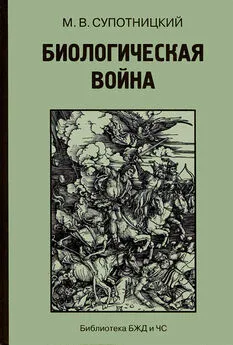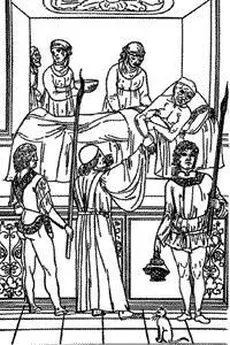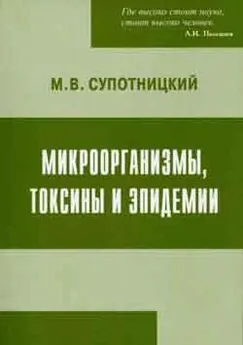Михаил Супотницкий - Биологическая война (Часть 3)
- Название:Биологическая война (Часть 3)
- Автор:
- Жанр:
- Издательство:Кафедра, Русская панорама
- Год:2013
- Город:Москва
- ISBN:978-5-93165-328-0
- Рейтинг:
- Избранное:Добавить в избранное
-
Отзывы:
-
Ваша оценка:
Михаил Супотницкий - Биологическая война (Часть 3) краткое содержание
Часть 3. Частная неправильная эпидемиология.
Биологическая война (Часть 3) - читать онлайн бесплатно полную версию (весь текст целиком)
Интервал:
Закладка:
Garcillian-Bracia M. P., de-la Crus F. Distribution of IS91 family insertion sequences in bacterial genomes: evolutionary implications // FEMS Microbiol. Ecol. 2002. V. 42. № 2. P. 303–313.
Geffeney S. L. Ruben P. C. The structural basis and functional consequences of interactions between tetrodotoxin and vouage-gated sodium channels // Mar Drugs. 2006. V 4. P. 143–156.
Geisbert T. W, Daddurlo-DiCaprio K. М., Geisbert J. B. et al. Marburg virus Angola infection of Rhesus macaques: pathogenesis and treatment with pecombinant nematode anticoagulant protem c2 // J. Infect. Dis. 2007. V. 196. P. 372–381.
Geisbert T. W., Pushko P., Anderson K. et al. Evaluation in nonhuman primates ofvaccines against Ebola virus // Emerg. Infect. Dis. 2002. V. 8. № 5 P. 503- 5G7.
Georges-Courbot М. C., Sanchez A., Lu Ch. Y. et al. Isolation and phylogenetic characterization of Ebola viruses causing different outbreaks in Gabon // Emerg. Infect. Dis. 1997. V. 3. № 1. P. 59–62.
Gerhard F. Brucella suis in aerated broth culture III. Continuous culture studies //J Bacteriol. 1946. V. 52. № 3. P. 283–292.
Ghigo E., Kartenbeck J., Lien P. et al. Ameobal pathogen mimivirus infects macrophages through phagocytosis // PLoS Pathogens. 2008. V. 4. № 6. P. 1–17.
Gibney K., Cheng A. C., Currie B. Cutaneous melioidosis.n the tropical top end ofAustralia: a prospective study and review of the literature // Clin. Infec Dis. 2008. V. 47. P. 603 609.
Gitgis H., Hottes A., Tavazoie S. Genetic architecture of intrinsic antibiotic susceptibility // PLoS ONF. 2009. V. 4, Is. 5. P. 5629.
Godoy D., Randle G., Simpson A. J. et al. Multilocus sequence typing and evolutionary relationships among the causative agents of melioidosis and glanders, burkholderia psendomallci and Burkholderia mallei // J. Clin. Microbiol. 2003. V. 41. P. 2068 2079.
Goff A. J., Chapman J., Foster C. et al. A novel respiratory model of infection with monkeypox virus in Cynomolgus macaques // J. Virol. 2011. V. 85 № 10. P. 4898 4909.
Goh E. B., Yim G., Tsui W. et al. Transcriptional modulation of bacterial gene expression by subinhibitory concentrations of antibiotics // Proc. Natl. Acad Sci. USA. 2002 V. 99. P. 17025-17030.
Goldberg М., Longer R., Jia X. Nanostructured materials for applications in drug delivery and tissue engineering // J. Biomater. Sci. Polym. 2007. V 18. № 3. P. 241–268.
Goncalves D. M., de Liz R., Girard D. Activation of neutrophils by nanoparticles // The Sci. World J. 2011 V 11. P. 1877–1885.
Gondor J. C., Kishimotc R. A., Kastello M. D. et al. Gynomolgus monkey model for experimental Q fever infection // J. Infect Dis. 1979. V. 139 № 2 P. 191–196.
Gooalow R. J., Leonard F. A. Viability and snfectivity of microorganisms in experimental airborne infection // Bad Reviews. 1961. V. 25. № 3 P. 182–187.
Gorman S, Viseshakul N, Col.en B. et al. A recombinant adenovirus that directs secretion of biologically active κ-bungarotoxin from mammalian cells // Molecular Brain Research 1997. V. 44, № 1. P. 143–146.
Gould I. A, Buckley A., Groeger B K. et al. Immune enhancement of yellow fever virus neurovirulence formice: studies of mechanisms involved // J. Gen. Virol. 1987. V. 68. № 3. P. 105- 12C
Green Т. М., Eigelsbach H. T. Immunity in tularemia: report of two cases of proved reinfection // Arch. Int Med. 1950. V 85. P. 777
Grеепе I. P., Paessler S., Austgen L. et al. Envelope glycoprotein mutations mediate equine amplification and virulence of epizootic Venezuelan equine encephalitis virus // J. Virol. 2005. V. 79. № 14. P. 9128–9133.
GreeneC. М., Reefhuis J., Christina Tan C. et al. Epidemiologic investigations of bioterronsm-related anthrax, New Jersey, 2001 // Emetg. Infect. Dis 2002. V. 8. № 10. P. 1048—1050
Griffith K. S., Mead P., Armstrong G. L. et al. Bioterrorism-relatcd inhalational anthrax in an eiderly woman, Connecticut, 2001 // Emerg. Infect. Dis. 2003. V. 9. № 6. P. 681–688.
Griffiths G. D., Phillips G. J., Holley J. Holley inhalation toxicology of ricin preparations: animal models, prophylactic and therapeutic approaches to protection // Inhal. Toxicol. 2C07. V. 19. P. 873 -887
Guame-J., Jernigan J. A., Wun-Ju Shieh et al. Pathologyano pathog inesis ofbioterrorism-reiated inhalational anthrax // Amer. J. Pathol. 2003. V. 163. № 2. P. 701–709.
GuamerJ., Zaki S. R. Histopathology and immunohistochemistry in the diagnosis of bioterroiism agents // J. Histochem. Cytochem. 2006. V. 54. № 1. P. 3—11.
Gubser G., Hue S., Kellam P. et al. Poxvirus genomes: a phylogenetic analysis // J. Gen. Virol. 2004. V. 85. P. 105–117.
Guillemin J. Scientists and the history of biological weapons, a brief historical overview cf the development of biological weapons in the twentieth century // EMBO Rep. 2006. V. 7. S45—S49.
Guillemin J. The 1979 anthrax epidemic in the USSR: applied science and political controversy // Proceeding of the American Philosophical Society. 2002. V. 146. № 1. P. 19–36.
Guiyoule A., Gerbaund G., Buchrieser C. et al. Transferable plasmid-mediated resistance of Yersinia pestL // Emerg. Infect. Dis. 2001. V. 7. P. 43–48.
Gyles C. L. Shiga toxin-producing Escherichia coli: An overview // J. Anim. Sci. 2007. V. 85. P. 45–62.
Hacein-Bey-Abina S., Gamgue A., WangC. P. et al. Inserlional oncogenesis in 4 patients after retrovirus-mediated gene therapy of SCID-X1 // J. Clin. Invest. 2008. V. 118. R 3132–3142.
Hacein-Bey-Abina S., Hauer J., Ltm A. et al. Efficacy of gene therapy for X-linked severe combined immunodeficiency // N. Engl. J. Med. — 2010 — V. 363. № 4. F 355–364.
Hacein-Bey-Abina S., le Deist F., CarherF. ei al. Sustained correction of X-hnked severe combined.mmuno-deficiency by ex vivo gene therapy // N. Engl. J. Med. 2002. V. 346. P. 1185–1193.
Hacein-Bey-Abma S., von Kalle C., Schmidt M. ei al. A serious adverse event after successful gene therapy for X-hnked severe combined immunodeficiency // N. Engl. J. Med. 2003. V. 348. № 3. P. 255–256.
Hacem-Bey-Abina S., Von Kalle C., Schmidt M. et al. LM 02-associated cional T-cell proliferation in two patients after gene therapy for SCIDX1 [see comment] // Science 2003. V. 30?. P. 415–419.
Hackstadt Т., Peacock M. G., Hitchcock P. Jet al. Lipopolysaccharide variation in Coxiella hurnettii: intrastrain heterogeneity m structure and antigenicity // Infect. Immun. 1985. V. 48. № 2. P. 359–365.
Haensch S., Bianucci R., Signoli M. et al. Distinct clones, or Yersinia pestis caused the Black Death // PLoS Pathog. 2010. V. 6. № 10. P. elOOl 134. doi: 10.1371/journal.ppat 1001134
Hahn C. S., Lustig S., Strauss E. G. et al. Western equine encephalitis virus is a recombinant virus // Proc. Natl. Acad. Sci. USA. 1988. V. 85. P. 5997–6001.
Halama A., Kulinski M, Librowski T. et al. Polymei based non-viral gene delivery as a concept for the treatment of cancer // Pharm. Rep 2009. V. 61. P. 993–999.
Halfmann P., Kim Jin Hyun, Ebihara H. et al. Generation of biologicallv contained Lbola viruses // Proc. Natl. Acad. Sci. USA. 2008. V. 105. № 4. P. 1129–1133.
HailingS. М., Detillux F. G., Tatum F. M. et al. Deletion of the BCSP31 gene of Brucella abortus by replacement // Infect. Immun. 1991. V. 59. № 11. P. 3863–3868.
Halpem J., Neale E Neurospecific binding internalization and retrograde axonal transport // Cun Top. Microbiol. Immunol. 1995. V. 195. № 1. P. 221–241.
Halstead S. В, Rojanasuphot S., Sangkawibha N. Original antigenic sin in dengue // Am. J. Trap. Med. Hyg. 1983 V. 32. № 1. P. 154–156.
Hanifm С T. The chemical and evolutionary ecology of tetrodotoxin (TTX) toxicity in terrestrial vertebrates // Mar. Drugs. 2010. V. 8. P. 577–593.
Hjolin N. I., Yun N., Zacks M. A. et al. Recombinant alphaviruses are safe and useful serological diagnostic toolls // Am. J. Trop. Med. Hyg. 2007. V. 76. № 4. P. 774–781
Нага T. J. Gustatory detection of tetrodotoxin and saxitoxin, and its competitive inhibition by quinine and strychnine in freshwater fishes // Mar. Drugs. 2011. V 9. P. 2283–2290.
Harty R. No exit: targeting the budding process to inhibit filovirus replication // Antiviral. Res. 2009. V. 81. № 3. P. 189–197.
Hartzell J., Wood-Morris R., Martinesz L. et al. Q fever: epidemiology, diagnosis, and treatment // Mayo Clin. Proc. 2008. V. 83. № 5. P. 574–579.
Harvie P., Wong F. M, Bally М. B. Use of poly(ethylene glycol) — lipid conjugates to regulate the surface attributes and transfection activity of lipid — DNA particles // J. Pharro Sci 2000. V. 89 P. 652–663.
Hatheway C. L. Toxigenic Clostridia // Clinical. Microbiol. Rev. 1990. V. 3. № 1. P. 66–98.
Hauri A. М., Hofstetter I., Seibold E. et al. Investigating an airborne tularemia outbreak, Ge.many // Emerg. Infect. Dis. 2010. V. 16. № 2. P. 238–243.
HauseslerS., Nimtz М., Domke T. et al. Purification and characterisation of a cytotoxic exolipid of Burkholderia pseudomallei // Infect Immunol. 1998. V. 66. P. 1588–1593.
Hawkey P. W. The origins and molecular basis of antibiotic resistance // BMJ. 1998. V. 317. P. 557–560.
Health aspects of chemical and biological weapons. Report of a WHO group of consultants, WHO, Geneva, 1970
Hearings before the select committee to study governmental operations with respect to intelligence activities of the United States Senate. Ninety-fourth congress, 1st session. Volume 1. Unaut horized storage of toxic agents. Sept. 16,17,18; 1975 Washington, U. S. Government Printing Office, 1975.
Hearings before the subcomimttee on health and scientific research of the committee on human resources of the United States Senate Ninety-fifth congress. 1 st session on examination of serious deficiencies in the defense department efforts to protect the human subjects March 8, May 23/1977. Washington, U S. Government Printing Office, 1977. P. 5–6.
Heath F., Haria P., Alexander C. Varying polimer architecture to deliver drugs // AAPS J. 2007. V. 9. № 2. P. E235-E240.
Henchal E. A, McCown J. М., Burke D. S. et al. Epitopic analysis of antigenic determinants on the surface of dengue-2 virions using monoclonal antibodies // Am. J. Trop. Med. Hyg. 1985. V. 34. P. 164–169.
Hendrickson R. C., Wang C., Hatcher E L. et al. Orthopoxvirus genome evolution: the role of gene loss // Viruses. 2010. V. 2. P. 1933–1967
Henke! J. S, Baldwin М. V, BarbieriJ. T. Toxins from bacteria // EXS. 2010. № 100. P. 1—29.
Henning S. J., Ledley F. D. Патент США 5821235, МПК 6A61K 31/704; A61M 5/14; C12N 15/09. Gene therapy using the intestine / заявитель Baylor College of Medicine, США; заявл. 20.01.1995, 376473; опубл. 13.10.1998
Herrero В. A., Ecklung A. E., Streett C. S. et al. Experimental botulism in monkeys — a clinical pathological study // Exp. Mol. Pathoi. 1967. V. 6. № 1. P. 84–95.
Hersh S. Chemical and biological warfare: America’s hidden arseral. London. 1968.
Hicks K. W., Sweeney D A., Cui X. et al. An overview of anthrax infection including the recently identified form of disease in injection drug users // Intensive Care Med. 2012. V. 38. № 7. P. 1092–1104.
Читать дальшеИнтервал:
Закладка:







![Михаил Супотницкий - Очерки истории чумы. Книга II. Чума бактериологического периода [без иллюстраций]](/books/1084186/mihail-supotnickij-ocherki-istorii-chumy-kniga-ii.webp)
![Михаил Супотницкий - Очерки истории чумы. Книга I. Чума добактериологического периода [без иллюстраций]](/books/1084187/mihail-supotnickij-ocherki-istorii-chumy-kniga-i-ch.webp)

